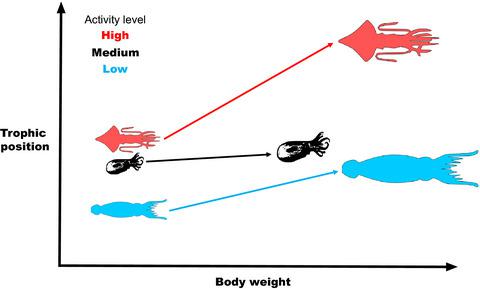当前位置:
X-MOL 学术
›
J. Anim. Ecol.
›
论文详情
Our official English website, www.x-mol.net, welcomes your
feedback! (Note: you will need to create a separate account there.)
Functional traits explain trophic allometries of cephalopods
Journal of Animal Ecology ( IF 3.5 ) Pub Date : 2020-09-28 , DOI: 10.1111/1365-2656.13333 Kieran J Murphy 1 , Gretta T Pecl 1 , Shane A Richards 2 , Jayson M Semmens 1 , Andrew T Revill 3 , Iain M Suthers 4, 5 , Jason D Everett 4, 6 , Rowan Trebilco 1, 3 , Julia L Blanchard 1
Journal of Animal Ecology ( IF 3.5 ) Pub Date : 2020-09-28 , DOI: 10.1111/1365-2656.13333 Kieran J Murphy 1 , Gretta T Pecl 1 , Shane A Richards 2 , Jayson M Semmens 1 , Andrew T Revill 3 , Iain M Suthers 4, 5 , Jason D Everett 4, 6 , Rowan Trebilco 1, 3 , Julia L Blanchard 1
Affiliation

|
Individual body size strongly influences the trophic role of marine organisms and the structure and function of marine ecosystems. Quantifying trophic position-individual body size relationships (trophic allometries) underpins the development of size-structured ecosystem models to predict abundance and the transfer of energy through ecosystems. Trophic allometries are well studied for fishes but remain relatively unexplored for cephalopods. Cephalopods are important components of coastal, oceanic, and deep-sea ecosystems, and they play a key role in the transfer of biomass from low trophic positions to higher predators. It is therefore important to resolve cephalopod trophic allometries to accurately represent them within size-structured ecosystem models. We assessed the trophic positions of cephalopods in an oceanic pelagic (0 - 500 m) community (sampled by trawling in a cold-core eddy in the western Tasman Sea), comprising 22 species from 12 families, using bulk tissue stable isotope analysis and amino acid compound-specific stable isotope analysis. We assessed whether ontogenetic trophic position shifts were evident at the species-level and tested for the best predictor of community-level trophic allometry among body size, taxonomy, and functional grouping (informed by fin and mantle morphology). Individuals in this cephalopod community spanned 2 trophic positions and fell into 3 functional groups on an activity level gradient: low, medium, and high. The relationship between trophic position and ontogeny varied among species, with the most marked differences evident between species from different functional groups. Activity level-based functional group and individual body size best explained cephalopod trophic positions (marginal R2 = 0.43). Our results suggest that the morphological traits used to infer activity level, such as fin-to-mantle length ratio, fin musculature, and mantle musculature are strong predictors of cephalopod trophic allometries. Contrary to established theory, not all cephalopods are voracious predators. Low activity level cephalopods have a distinct feeding mode, with low trophic positions and little-to-no ontogenetic increases. Given the important role of cephalopods in marine ecosystems, distinct feeding modes could have important consequences for energy pathways and ecosystem structure and function. These findings will facilitate trait-based and other model estimates of cephalopod abundance in the changing global ocean.
中文翻译:

功能特征解释了头足类动物的营养异种
个体体型强烈影响海洋生物的营养作用以及海洋生态系统的结构和功能。量化营养位置-个体体型大小关系(营养异变)支持大小结构生态系统模型的发展,以预测生态系统中的丰度和能量转移。鱼类的营养异基因组学得到了很好的研究,但对头足类动物的研究仍然相对较少。头足类动物是沿海、海洋和深海生态系统的重要组成部分,它们在生物量从低营养位置转移到高级捕食者的过程中发挥着关键作用。因此,重要的是解决头足类动物的营养异变以在大小结构的生态系统模型中准确地表示它们。我们评估了大洋中上层 (0 - 500 m) 群落中头足类动物的营养位置(通过在西塔斯曼海的冷核涡流中拖网捕捞采样),包括来自 12 个科的 22 个物种,使用大量组织稳定同位素分析和氨基酸化合物特定的稳定同位素分析。我们评估了个体发生的营养位置变化在物种水平上是否明显,并测试了体型、分类和功能分组(由鳍和地幔形态告知)之间群落水平营养异速生长的最佳预测因子。这个头足类群落中的个体跨越 2 个营养位置,并在活动水平梯度上分为 3 个功能组:低、中和高。营养位置和个体发育之间的关系因物种而异,来自不同功能组的物种之间的差异最为明显。基于活动水平的功能组和个体体型最能解释头足类动物的营养位置(边际 R2 = 0.43)。我们的研究结果表明,用于推断活动水平的形态特征,例如鳍与地幔的长度比、鳍肌肉组织和地幔肌肉组织,是头足类动物营养异位分布的强预测因子。与既定理论相反,并非所有头足类动物都是贪婪的捕食者。低活动水平的头足类动物具有独特的摄食模式,低营养位置和几乎没有个体发育增加。鉴于头足类动物在海洋生态系统中的重要作用,不同的摄食方式可能对能量途径和生态系统结构和功能产生重要影响。
更新日期:2020-09-28
中文翻译:

功能特征解释了头足类动物的营养异种
个体体型强烈影响海洋生物的营养作用以及海洋生态系统的结构和功能。量化营养位置-个体体型大小关系(营养异变)支持大小结构生态系统模型的发展,以预测生态系统中的丰度和能量转移。鱼类的营养异基因组学得到了很好的研究,但对头足类动物的研究仍然相对较少。头足类动物是沿海、海洋和深海生态系统的重要组成部分,它们在生物量从低营养位置转移到高级捕食者的过程中发挥着关键作用。因此,重要的是解决头足类动物的营养异变以在大小结构的生态系统模型中准确地表示它们。我们评估了大洋中上层 (0 - 500 m) 群落中头足类动物的营养位置(通过在西塔斯曼海的冷核涡流中拖网捕捞采样),包括来自 12 个科的 22 个物种,使用大量组织稳定同位素分析和氨基酸化合物特定的稳定同位素分析。我们评估了个体发生的营养位置变化在物种水平上是否明显,并测试了体型、分类和功能分组(由鳍和地幔形态告知)之间群落水平营养异速生长的最佳预测因子。这个头足类群落中的个体跨越 2 个营养位置,并在活动水平梯度上分为 3 个功能组:低、中和高。营养位置和个体发育之间的关系因物种而异,来自不同功能组的物种之间的差异最为明显。基于活动水平的功能组和个体体型最能解释头足类动物的营养位置(边际 R2 = 0.43)。我们的研究结果表明,用于推断活动水平的形态特征,例如鳍与地幔的长度比、鳍肌肉组织和地幔肌肉组织,是头足类动物营养异位分布的强预测因子。与既定理论相反,并非所有头足类动物都是贪婪的捕食者。低活动水平的头足类动物具有独特的摄食模式,低营养位置和几乎没有个体发育增加。鉴于头足类动物在海洋生态系统中的重要作用,不同的摄食方式可能对能量途径和生态系统结构和功能产生重要影响。











































 京公网安备 11010802027423号
京公网安备 11010802027423号